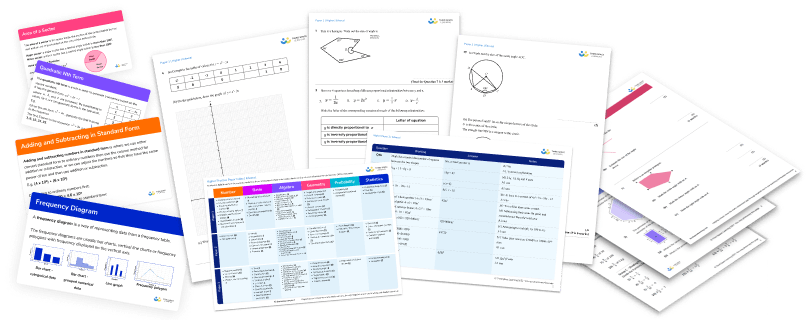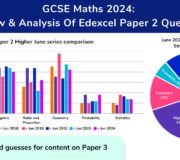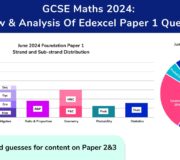GCSE Maths Paper 3 2024 Topic Analysis: Gaps, Distribution & Complexity
This article was originally published on 11th June 2024.
GCSE Maths Paper 3 2024 is now complete, signalling the end of this GCSE Maths paper series. Christine Norledge returns with her in-depth analysis of Paper 3 Foundation and Higher, and how they compare to previous series.
That’s a wrap! This year’s final GCSE Maths paper was completed on Monday (10th June). Although students nationwide can soon start unwinding and enjoying their well-deserved summer break, our work continues.
DID YOU KNOW?
We’ll be providing more in-depth analysis of this year’s papers, before returning on Results Day, Thursday 22nd August, to review the performance of this year’s cohort.
Before we take a closer look at this year’s Foundation and Higher Paper 3s, let’s revisit the hit lists for Papers 2 and 3 to identify what topics were not covered.
GCSE MATHS 2024: STAY UP TO DATE
Join our email list to stay up to date with the latest news, revision lists and resources for GCSE maths 2024. We’re analysing each paper during the course of the 2024 GCSEs in order to identify the key topic areas to focus on for your revision.
Thursday 16th May 2024: GCSE Maths Paper 1 2024 Analysis & Revision Topic List
Monday 3rd June 2024: GCSE Maths Paper 2 2024 Analysis & Revision Topic List
Monday 10th June 2024: GCSE Maths Paper 3 2024 Analysis
GCSE 2024 dates
GCSE 2024 results
GCSE results 2023
Which topics appeared and which were missing in the 2024 Calculator papers?
Note that this is an updated version of our hit lists for Papers 2 and 3, not a complete list of topics on each paper.
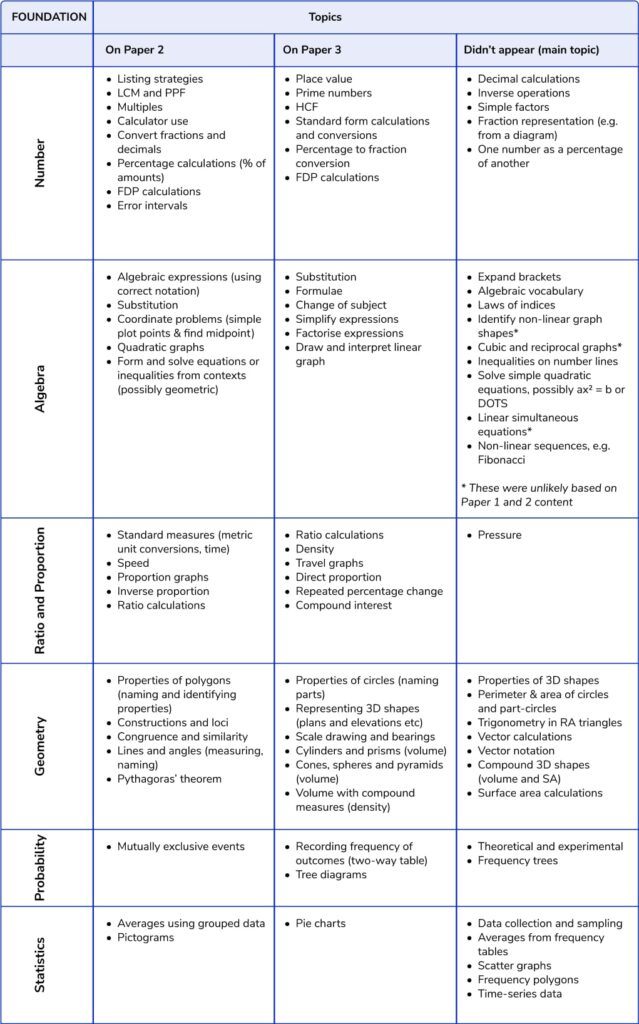
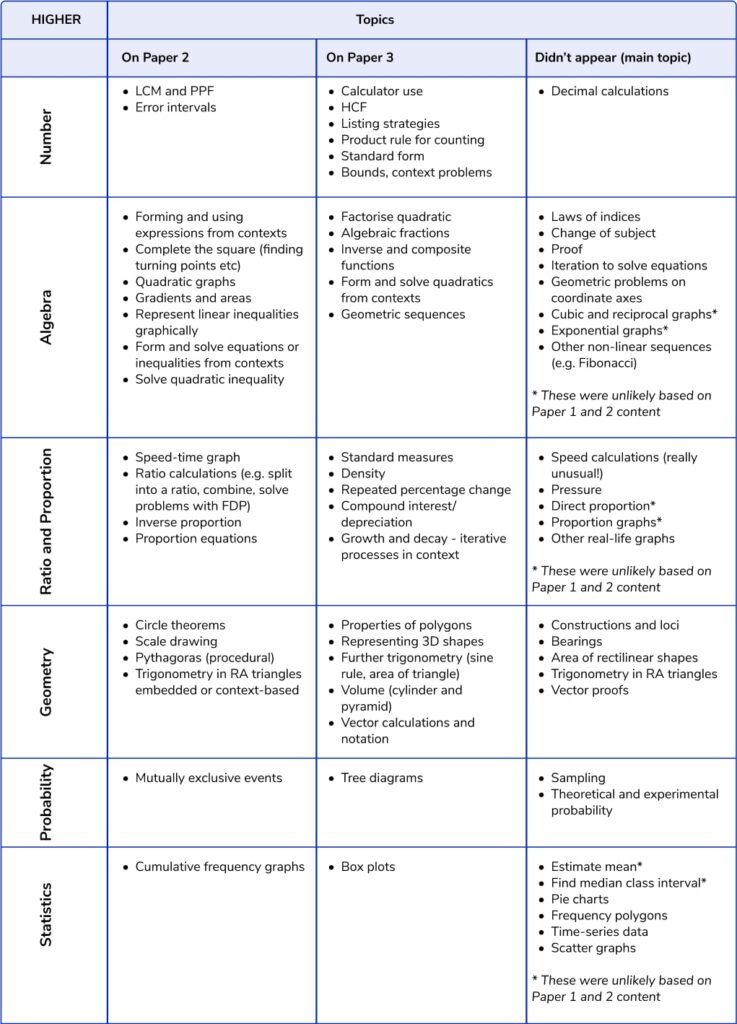
GCSE Maths Topic List Foundation & Higher
Your go-to year-on-year GCSE maths topic list for every student to focus revision for exams. Covering all main GCSE math topics, you'll get dedicated Foundation and Higher lists with links to our library of free downloadable resources. Features worksheets, exam questions, diagnostic questions, revision mats and much more!
Download Free Now!Paper 3 not exempt from exam unpredictability
Examiners enjoy keeping us on our toes, so it’s not surprising that we’ve encountered some unexpected topic repetitions or omissions.
Ofqual is making considerable effort to ensure exam papers don’t become too predictable (see Predicting predictability (2020) for an insightful discussion on this). As such, it’s reasonable to expect some inaccuracies in any revision hitlist.
Focusing on Paper 3:
- Linear graphs appeared again on Paper 3 Foundation, which was surprising given the amount of graph work students had already done on the previous two papers;
- Repeated percentage change appearing twice on the Higher paper (one common, one Higher-only);
- Volume assessed twice on Higher (one common, one Higher-only).
Paper 3 left unexpected gaps at Foundation and Higher
Revision hit lists are often extensive and cover possibilities rather than predictions. As such, we should anticipate that not every topic on these lists would appear within a series.
That said, Paper 3 did leave a couple of significant gaps:
- No straightforward trigonometry work, meaning that Foundation students haven’t done any trigonometry at all this series;
- Nothing else on speed on Higher, which is unusual as it’s often appeared on multiple papers in previous series.
Stay tuned for our next blog, where we’ll provide a comprehensive analysis of all three 2024 papers, including a more in-depth discussion of content gaps across the series.
Student responses to Maths Paper 3
The optimism after Paper 2 seems to have diminished slightly, with some students finding this paper very challenging.
Much of the chat on social media was about the final question on the Higher paper; it’s a lovely question if you’re a maths geek, but it proved too much for a significant majority of candidates.
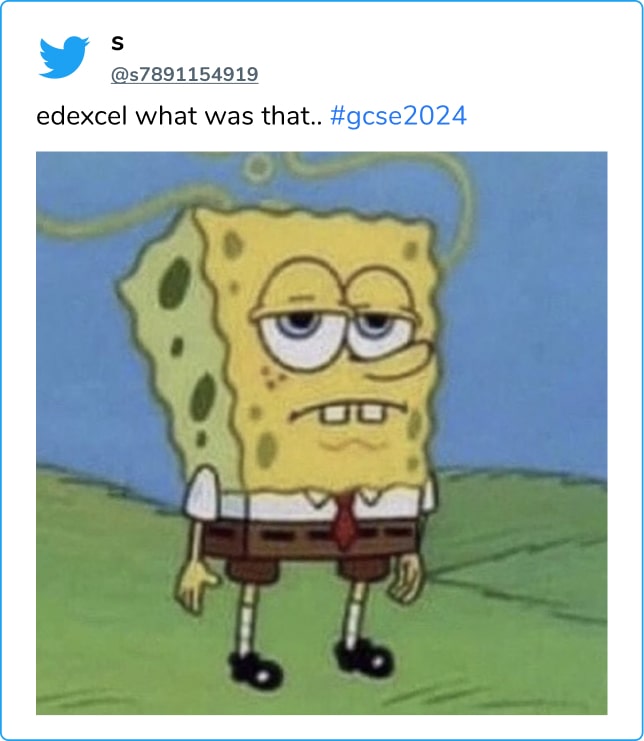
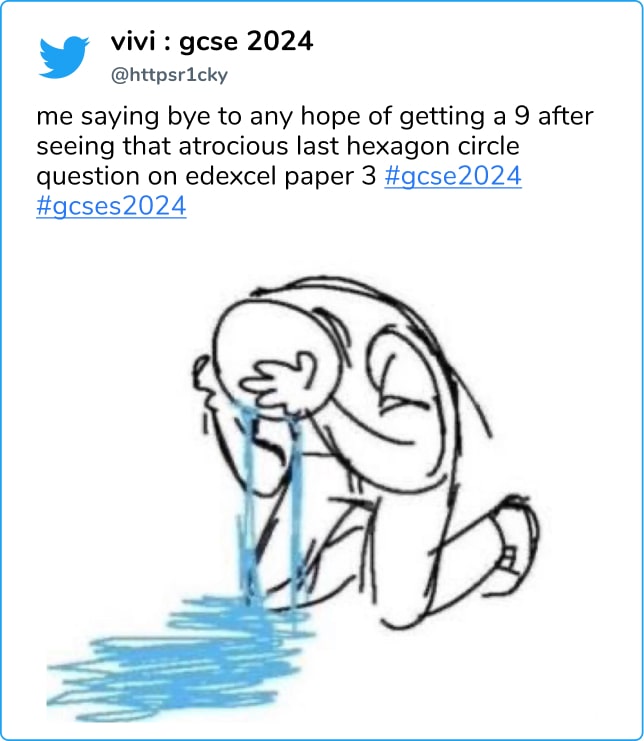

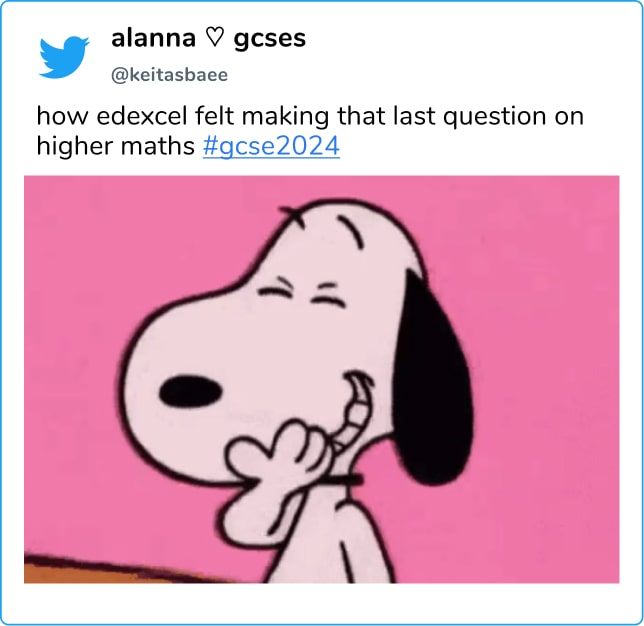
This cohort has now completed their GCSE Maths, and some are thrilled at the thought of “never doing maths again”. Let’s now turn to the final papers and see if student reactions were justified.
Analysis process for Maths Paper 3
In this blog, I’ve applied the same processes and classifications as in my previous exam analysis blog posts:
- Question Level Analysis Of Edexcel Maths Past Papers (Foundation) (2017-2023)
- Question Level Analysis Of Edexcel Maths Past Papers (Higher) (2017-2023)
Refer to my previous GCSE Maths Paper 1 2024 blog for more on the processes used.
Detailed analysis of Maths Paper 3 Foundation 2024
Paper 3 Foundation was a fair and accessible paper that broadly ramped up difficulty
Although students didn’t feel like they had as easy a ride as last year, this year’s Foundation Paper 3 was a fair and accessible paper. Much like Paper 2, the difficulty level ramped up slowly.
There were still lots of procedural questions in the first half, but, unlike Paper 2, there were more multi-mark wordier questions earlier on. However, there were also some easier questions interspersed later on in the paper, such as Q12 requiring students to write down three prime numbers for 2 marks, and Q10 naming parts of a circle.
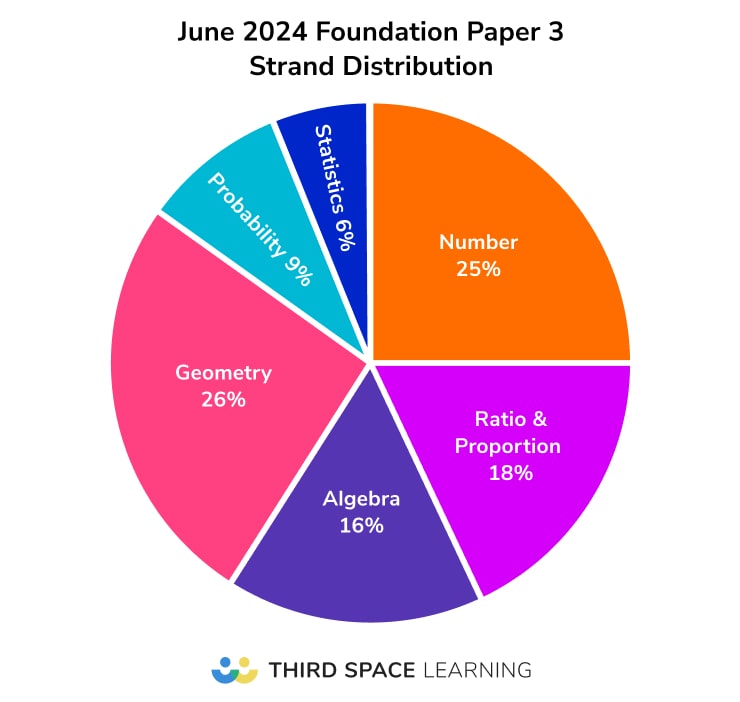
The common questions were a mixed bag. There were some straightforward marks up for grabs on finding the HCF, standard form and tree diagrams, which many Foundation candidates should have performed fairly well on.
However, there were some more challenging problems, such as the density question involving tins of flour. Additionally, the more unusual context for repeated percentage change in Q4 may have thrown some students, who may not have recognised “compound interest” in a different guise.
Paper 3 Foundation had more standard procedural questions than Paper 1
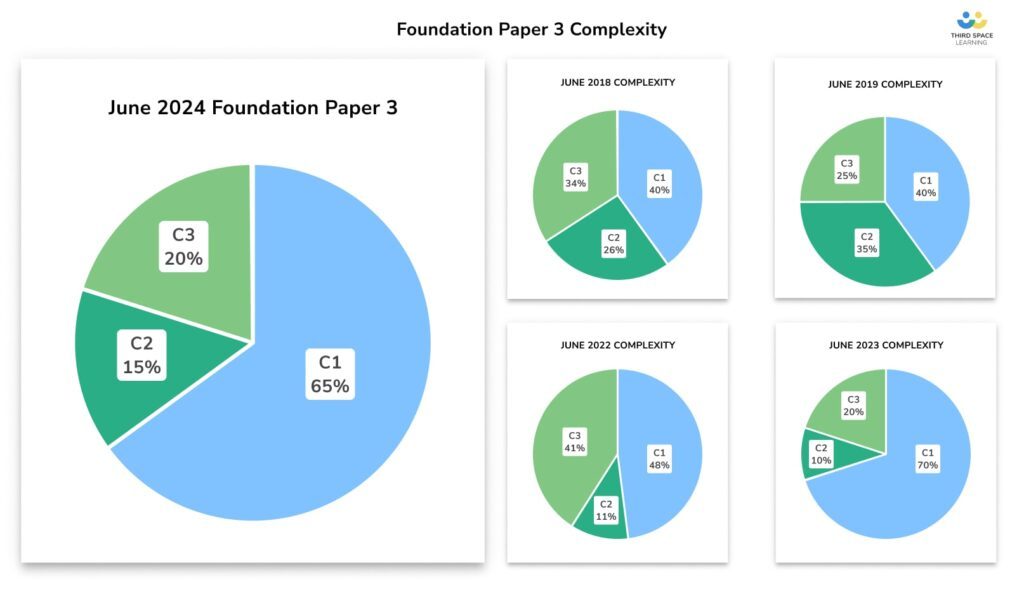
When we consider complexity scores for this paper, we can see why it feels a bit easier than Paper 1. I categorised 65% of the paper as C1 (standard procedural questions), putting it roughly on par with last year’s Paper 3. Looking at the series as a whole, we can see more C1 content (and consequently less C3 content) as we go through the papers.
| Foundation 2024 | C1 | C2 | C3 |
|---|---|---|---|
| Paper 1 | 51% | 18% | 31% |
| Paper 2 | 61% | 10% | 29% |
| Paper 3 | 65% | 15% | 20% |
The proportion of C2 marks (interpret/explain/show that) is comparable to post-pandemic papers of June 2022 and 2023. It will be interesting to see whether this remains typical for Edexcel Foundation papers going forward or whether we see a gradual return to pre-pandemic proportions.
Paper 3 Foundation heavy on Geometry and lighter on Statistics
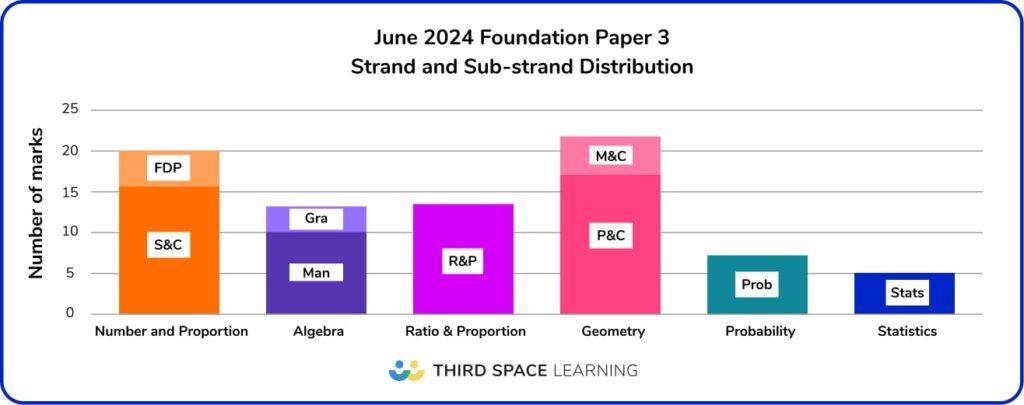
This year’s Paper 3 was heavy on Geometry, which was to be expected as this was lighter on Paper 2 this year. In particular, 10% of the marks on the whole paper included work on volume (density and finding the volume of a cylinder), both in the common questions.
Algebra content on this paper was around average. It wasn’t surprising to see more work on algebraic manipulation in this paper, but it was unexpected to have yet another question on linear graphs, meaning that this series has one of the highest proportions of marks for graph work of all series since June 2017.
Statistics content was slightly lighter than Probability on this paper, but it is often the case that one of the two is more favoured on different papers in each series.
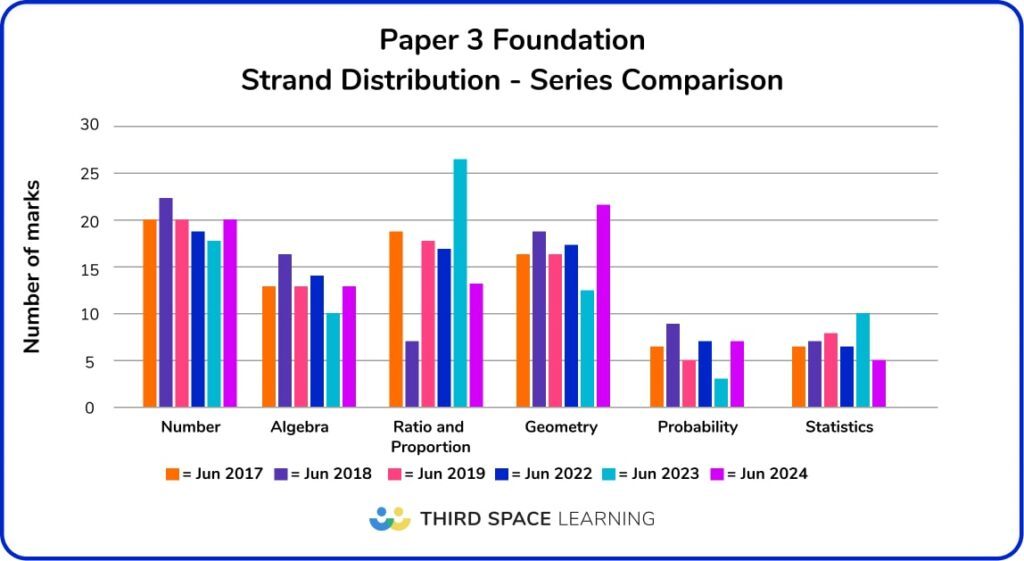
Detailed analysis of Maths Paper 3 Higher 2024
Paper 3 Higher generally accessible with a slower difficulty ramp
Despite some student reactions to the contrary, this year’s Higher paper also generally felt accessible.
The common questions provided some easy wins in HCF, standard form, percentage change and tree diagrams. When we got into the Higher-only content from Q8 onwards, the vectors problem and the other volume question continued the slower difficulty ramp.
There were a couple of trickier problems earlier on, such as Q10 (using algebra in a ratio problem) and Q14 (a different twist on compound interest). However, procedural work continued throughout the paper, with Q15 in particular offering some really easy wins for that stage in the paper.
Inevitably, the final question caused some consternation, but it’s worth remembering that putting something like this as the final question on Paper 3 is not unusual for Edexcel, and it’s clearly there to stretch the most able of grade 9 candidates.
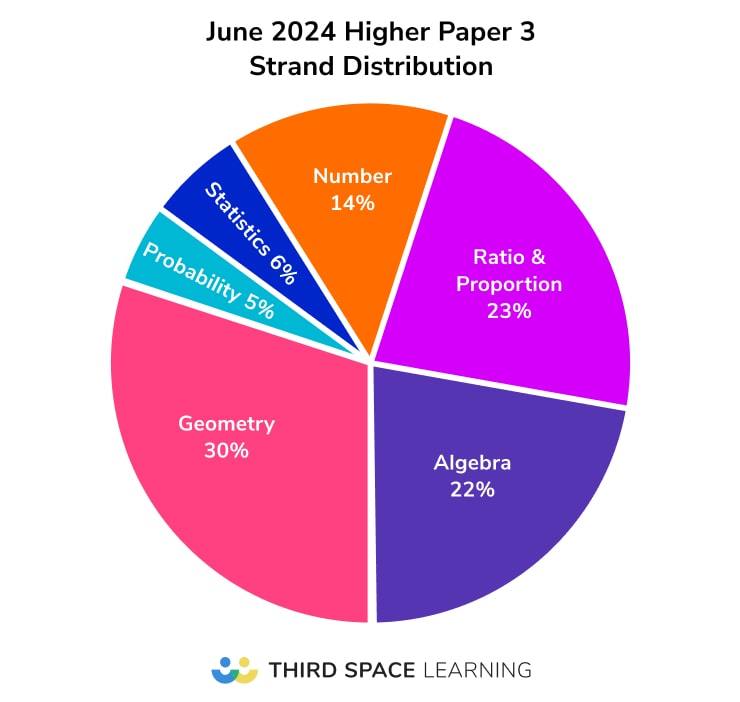
Paper 3 Higher featured way more standard procedural questions than previous series
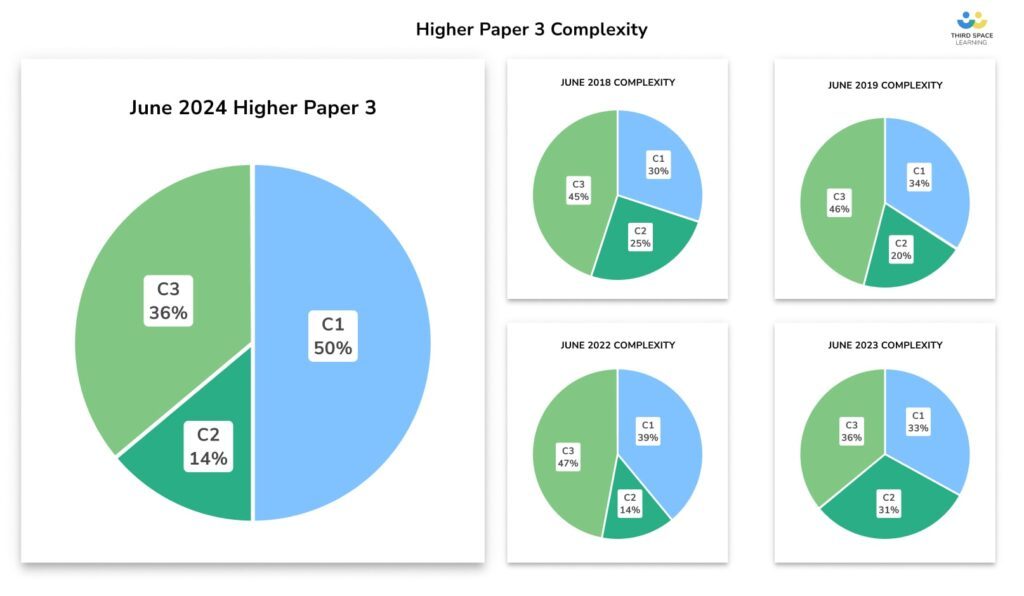
The proportion of standard procedural (C1) questions on this paper was significantly greater than previous Paper 3s; it is unusual for me to classify half of a Higher paper in this way!
C3 questions were a little on the low side when compared with previous series, but not significantly so, particularly when we look at the complexity distribution for last year’s June Paper 3.
| Higher 2024 | C1 | C2 | C3 |
|---|---|---|---|
| Paper 1 | 42% | 13% | 45% |
| Paper 2 | 36% | 25% | 39% |
| Paper 3 | 50% | 14% | 36% |
We’ve had fewer C2 (interpret/explain/show that) questions than usual on both Papers 1 and 3 this year. This is in part due to a greater proportion of Statistics content requiring students to draw graphs rather than interpret them, but also because there have been relatively few questions requiring students to comment on mistakes or to consider how their answer might change if something is altered in the question.
Overall Geometry dominated while Algebra appeared less on Paper 3 Higher
As expected, Geometry and Ratio and Proportion featured highly on this paper, filling in some of the gaps from Paper 2. In particular, we saw a heavy focus on volume calculations and more work on compound measures. Overall, though, trigonometry remained light, with only one question on Higher-level trigonometry in this paper.
There was less work than expected on Algebra in this paper, leaving the series as a whole slightly on the low side. In particular, equations, inequalities and formulae (including changing subject) appeared less frequently than usual.
Statistics and Probability were fairly evenly balanced in this paper but were both on the low side. Frequently occurring topics such as scatter graphs and frequency polygons did not appear in the crossover content on any of the papers.
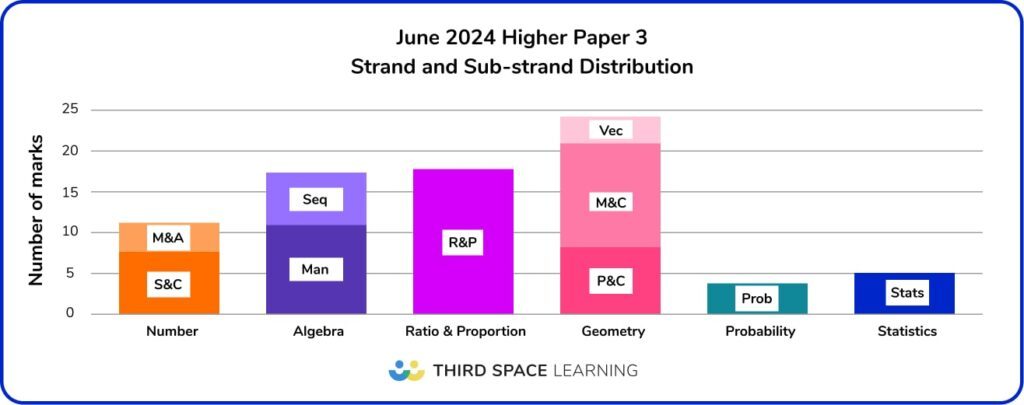
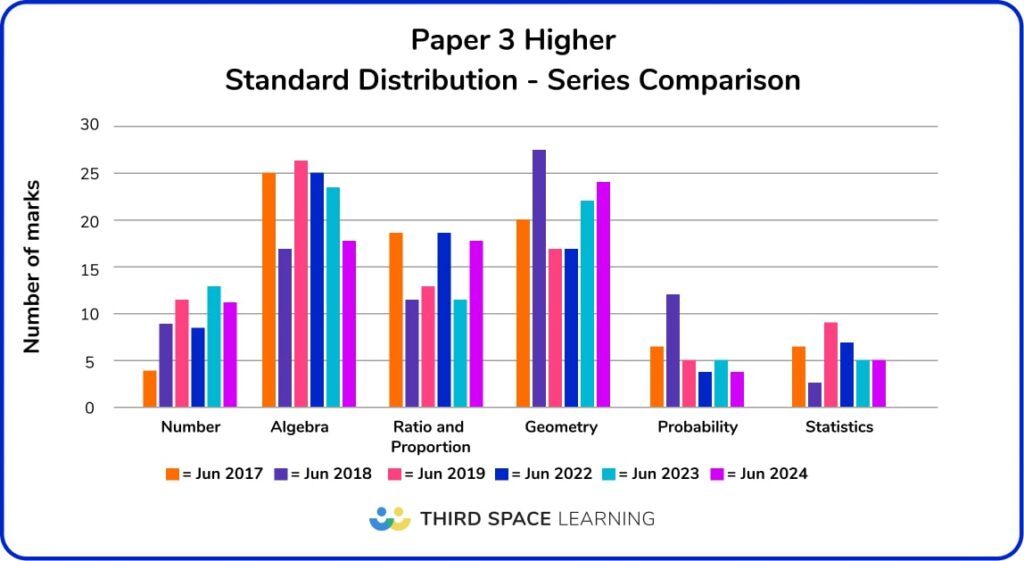
What’s next for GCSE Maths 2024?
With the exams now behind us, we’ve still got a couple more analyses of this year’s GCSE Maths papers for you!
In early July, we’ll be back with a detailed analysis of the June 2024 series as a whole. This time, we’ll take a more forward-looking approach, exploring how these papers can inform teaching, exam preparation and revision strategies for next year’s exam cohort.
Finally, we’ll return on GCSE Results Day, Thursday 22nd August, to review how students performed on the papers we’ve discussed in this series.
DO YOU HAVE STUDENTS WHO NEED MORE SUPPORT IN MATHS?
Every week Third Space Learning’s specialist online GCSE maths tutors support thousands of students across hundreds of schools with weekly online 1 to 1 maths lessons designed to plug gaps and boost progress.
Since 2013 these personalised one to one lessons have helped over 150,000 primary and secondary students become more confident, able mathematicians.
Learn about the GCSE revision programme or request a personalised quote for your school to speak to us about your school’s needs and how we can help.
